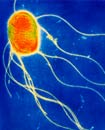Salmonella enterica: foodborne illness: Difference between revisions
No edit summary |
No edit summary |
||
| Line 5: | Line 5: | ||
==Salmonella enterica== | ==<i>Salmonella enterica</i>== | ||
<br> | <br> | ||
| Line 14: | Line 14: | ||
==Prevention== | ==Prevention== | ||
<br>The most effective way to prevent Salmonella infections is to thoroughly cook all meats. The United States Department of Agriculture has also published guidelines to prevention. These include washing your hands and cooking surfaces often as well as washing hands, cooking utensils, and cooking surfaces with hot, soapy water before handling any food. Because red meat, poultry, and seafood are more susceptible to carrying Salmonella, they also recommend separating these foods from other food in your refrigerator. Cooking at proper temperatures and refrigeration are important steps in preventing Salmonella outbreaks.<br> | <br>The most effective way to prevent <i>Salmonella infections</i> is to thoroughly cook all meats. The United States Department of Agriculture has also published guidelines to prevention. These include washing your hands and cooking surfaces often as well as washing hands, cooking utensils, and cooking surfaces with hot, soapy water before handling any food. Because red meat, poultry, and seafood are more susceptible to carrying <i>Salmonella</i>, they also recommend separating these foods from other food in your refrigerator. Cooking at proper temperatures and refrigeration are important steps in preventing <i>Salmonella outbreaks</i>.<br> | ||
==Conclusion== | ==Conclusion== | ||
Revision as of 17:02, 23 April 2011
kdjfhgks

Salmonella enterica
Putrefaction
Include some current research in each topic, with at least one figure showing data.
Prevention
The most effective way to prevent Salmonella infections is to thoroughly cook all meats. The United States Department of Agriculture has also published guidelines to prevention. These include washing your hands and cooking surfaces often as well as washing hands, cooking utensils, and cooking surfaces with hot, soapy water before handling any food. Because red meat, poultry, and seafood are more susceptible to carrying Salmonella, they also recommend separating these foods from other food in your refrigerator. Cooking at proper temperatures and refrigeration are important steps in preventing Salmonella outbreaks.
Conclusion
Overall paper length should be 3,000 words, with at least 3 figures.
References
Edited by student of Joan Slonczewski for BIOL 238 Microbiology, 2009, Kenyon College.
